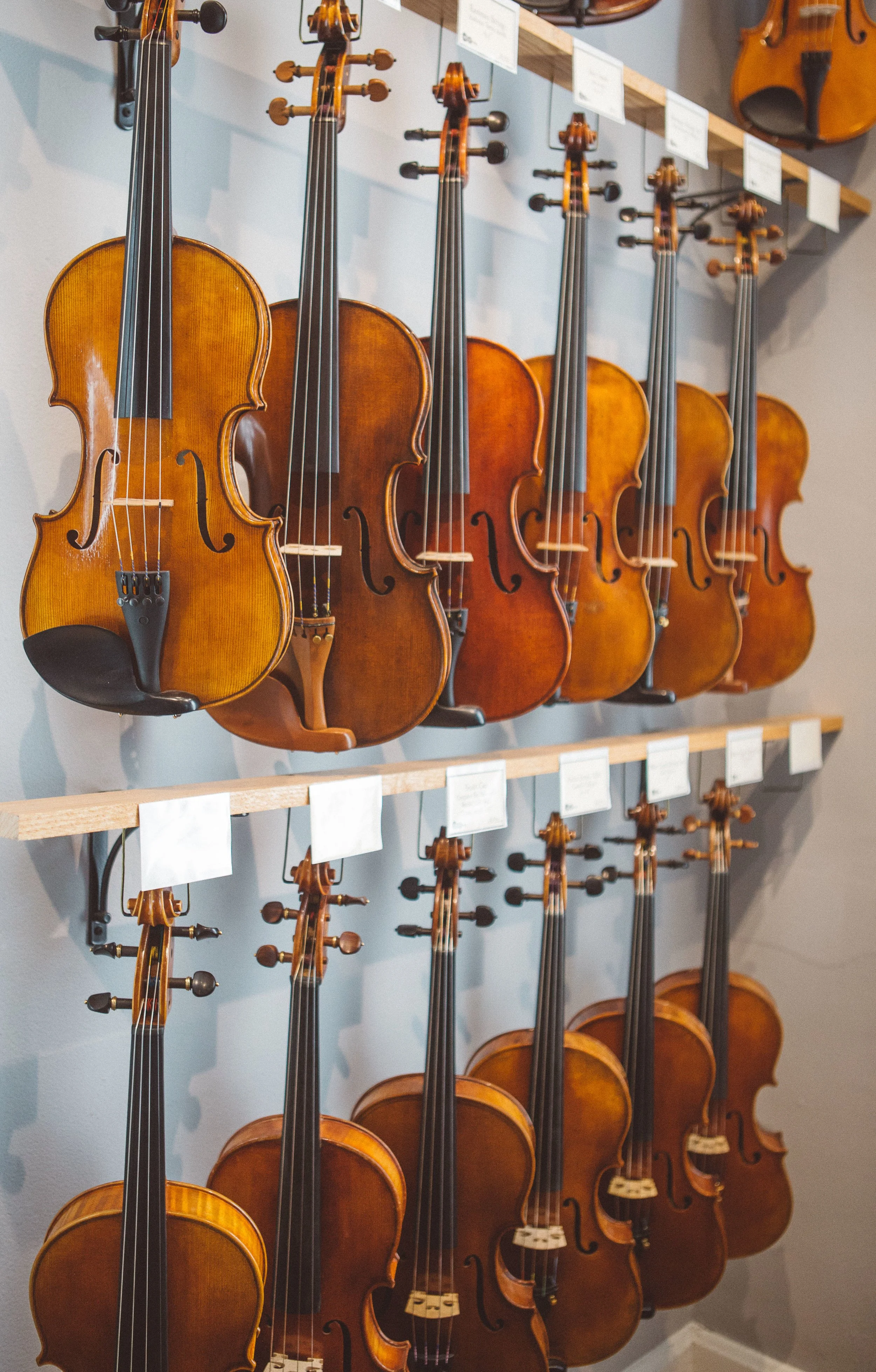THE VIOLIN: PRACTICING SLOWLY
““One must always practice slowly. If you learn something slowly, you forget it slowly.””
The violin is an instrument that takes a lot of practice and dedication to learn to play well. One technique that many musicians use to improve their skills is to study the violin slowly.
Playing the violin isn’t just about hitting the right notes. To truly master the instrument, you need to understand the music you’re playing. Take the time to analyze the piece you’re working on, paying attention to its structure, melody and rhythm. Listen to recordings of professional violinists performing the piece and try to pick up on their nuances and interpretations. You should also strive to infuse your playing with emotion and passion. Don’t just play mechanically; put some feeling into your playing. This will help you connect with the music on a deeper level and make your performances more engaging for your audience.
When it comes to violin practice, the right mindset and concentration can make all the difference. It’s important to approach your practice sessions with a clear goal in mind, whether that’s mastering a difficult passage or improving your overall technique. It’s also helpful to take a few minutes to ‘set the scene’ before you start playing. Find a quiet space where you won’t be interrupted, take a few deep breaths and focus your mind on the task at hand. During your practice session, make a conscious effort to stay focused on your playing. It’s easy to let your mind wander, especially when you’re playing a piece you’ve practiced many times before. But by paying attention to the nuances of your playing and striving to improve, you’ll make the most of your practice time.
Basic recommendations
➤ Start by studying the piece of music you want to learn to play very slowly. It is advisable to start practicing at half or even a quarter of normal speed. Use a metronome to keep the rhythm and make sure you are playing at the right speed. Using a metronome will help you keep a steady rhythm and allow you to gradually increase the speed as you become more comfortable playing the piece.
➤ Pay attention to detail: playing slowly allows you to focus on the details of the piece, such as intonation, tone quality, articulation and phrasing. This will help you improve your technique and ensure that you are playing the piece correctly and accurately.
➤ Focus your study: you can practice in sections, using different rhythmic patterns and varying dynamics and pitch to improve your playing. Don’t get into the habit of playing from beginning to end. Focus on the difficult passages in the first part of your study, when your concentration will be greatest, and be patient and consistent. Slow practice can be frustrating at first, but remember that it is an effective technique for improving your violin skills.
➤ Dedicate time and effort to this practice technique and you will see an improvement in your technique and ability to play the violin. Remember that slow study should not be the only way you practice the violin. It is important to vary your practice and work on different aspects of the instrument, such as technique, tone, interpretation and score reading. With constant practice and dedication, you will be able to improve your violin skills and enjoy playing this wonderful instrument.
Benefits
➤ Build muscle memory: when learning a new piece or technique, it’s important to build muscle memory in order to perform effortlessly. Slow practice helps you learn the correct movements and build the necessary strength and flexibility.
➤ Improving accuracy: playing slowly allows the violinist to focus on accuracy and precision in their playing. It’s easier to hear and correct mistakes at a slower tempo, which will ultimately lead to better playing.
➤ Developing control: slow practice helps violinists develop control over their playing, including intonation, tone and dynamics. This control can then be transferred to faster playing, leading to more polished and expressive performances.
➤ Avoiding bad habits: when practicing at a fast tempo, it’s easy to develop bad habits that can be difficult to correct later. Practicing slowly allows the violinist to focus on proper technique and avoid developing bad habits in the first place.
➤ Reducing tension: practicing at a slower tempo can help the violinist reduce tension in their playing, which can lead to better sound and lesser risk of injury. It’s common to tense up when playing fast, but practicing slowly can help the violinist stay relaxed and in control.
Some techniques
➤ Break the piece into small sections: instead of trying to play the entire piece slowly, break it into smaller sections of 2-4 bars. Play each section slowly, focusing on accuracy and control.
➤ Play in rhythms: take a short section of the piece and break it into smaller rhythmic units, such as two or four beats. Practice each rhythmic unit slowly and accurately, gradually increasing speed as you gain control.
➤ Practice with a tuning fork: play the piece slowly while looking at the tuning fork. This will help you develop your intonation and pitch accuracy.
➤ Use expressive techniques: even when practicing slowly, you can still use expressive techniques such as vibrato, dynamic changes and phrasing. This will help you develop your musicality and expression even at a slow tempo.
Measure your progress
Measuring your progress with slow practice on the violin can be a little more challenging than with faster playing, since the improvements you make may not be immediately apparent. However, there are several ways to measure your progress:
➤ Record yourself: record yourself playing the piece at a slow tempo and then listen to the recording. This will help you identify areas where you need improvement as well as areas where you have made progress.
➤ Track your metronome speed: keep track of the tempo at which you can play the piece accurately and comfortably. As you practice, gradually increase the metronome speed and track your progress over time.
➤ Evaluate your tone: slow practice allows you to focus on your tone production and sound quality. Pay attention to your bowing technique and try to produce a clear and consistent tone.
➤ Evaluate your control: slow practice helps you develop control over your playing, so pay attention to your dynamics, intonation, your tone and phrasing. Can you play with a smooth and even tone?
By keeping track of these different elements, you can get a sense of your progress over time and see how your slow practice is paying off in improved technique, accuracy and musicality.
Final thoughts
Learning to play the violin is a lifelong journey and it is important to focus on your goals, dedication and perseverance. Here are some final thoughts on violin practice:
➤ Maintain a positive mindset: when learning to play the violin, it’s essential to maintain a positive mindset. Focus on what you have achieved and look forward to what you will accomplish in the future. Remember to stay patient and persevere through challenges.
➤ Practice consistently: consistency is key when learning to play the violin. It’s better to practice for a shorter amount of time and be consistent rather than practicing for long hours sporadically. Make sure to set aside dedicated practice time and stick to it.
➤ Find resources and support: there are many resources available to help you learn and improve your playing. Consider taking lessons, joining an orchestra or ensemble, and seeking feedback from others. Surround yourself with supportive people who can encourage and motivate you in your journey of violin playing. In conclusion, these tips and benefits can help you on your journey of learning to play the violin. Remember to practice slowly, stay positive, and seek out resources and support.
Frequently Asked Questions
-
Slow practice in violin playing means playing a passage or song at a significantly slower tempo than its performance speed. It is an essential part of violin practice that helps develop a musician’s technique, intonation and musicality.
-
Slow practice is crucial in violin playing as it helps the player to focus on intonation, rhythm and technique. It also allows the player to break down complex passages into smaller parts, making them easier to master over time.
-
The amount of time spent practicing slowly varies from player to player. However, it is ideal to start with short fifteen to twenty-minute practice sessions and gradually increase the time as you progress.
-
Yes. A metronome is an essential practice tool when practicing the violin slowly. It helps players maintain a steady tempo and improves their sense of rhythm and timing.
-
Some tips for developing good violin practice habits include setting aside a dedicated practice time each day, breaking down complex passages into smaller parts, using a music stand, taking breaks regularly and staying motivated to achieve your musical goals.
-
Yes. It is best to practice the violin on a music stand as it helps players maintain good posture and prevent bad playing habits such as hunching over or looking down at the sheet music.
-
No. Slow practice should be a part of a player’s practice routine, but it should not be the only way to practice the violin. Players should also practice playing at performance speed to develop their playing skills and learn how to play the violin at different tempos.
-
Intonation is essential in violin playing as it refers to the accuracy of a player’s pitch. Good intonation is crucial for playing in tune with others and conveying the right emotions and musical expressions in a piece of music.
-
Slow practice helps players pay attention to the details of their playing, such as bowing, fingering and tone production. By practicing slowly, players can identify and correct any mistakes or weaknesses in their playing, improving their overall technique.
-
It’s much better to practice the violin by setting specific goals and focusing on improving skills that challenge you. Playing any song you want may not require you to stretch yourself and learn new skills, resulting in limited progress over time.
Read more articles
Quick video tips
““Start by studying the piece of music you want to learn to play very slowly.” ”




























